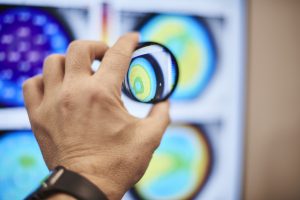How Laser Eye Surgery can Correct even the Need for “Milk Bottle” Specs

For decades, Laser Eye Surgery has been helping millions of people rid themselves of pesky glasses and contact lenses. But over the years, those with particularly strong “milk bottle” specs (as they are often affectionately called), have all too often been told they are unsuitable for this life-changing procedure. Thankfully, this scenario is becoming increasingly rare – at least at independent Laser Eye Surgery clinics.
So, let’s take a closer look at how Laser Eye Surgery can now treat even the need for “milk bottle” specs.
What is a High Glasses Prescription?
It is thought that around 4 billion people around the world wear glasses – that’s almost half of the global population! This need for glasses can be due to short-sightedness (myopia), long-sightedness (hyperopia), astigmatism, or even presbyopia (ageing eyes). However, the extent of these glasses-imposing prescriptions can vary significantly.
Some people may require only a small amount of correction – that is, they have a low prescription; however, others may have a high prescription that requires more correction. For particularly high prescriptions, thicker lenses are generally required, hence the term “milk bottle” lenses. But what actually constitutes a “high” glasses prescription?
Well, that depends on who you ask. But first of all, let’s cover the basics of a prescription.
At its simplest, your prescription should feature either a plus (+) or a minus (-) symbol followed by a number. These symbols represent either hyperopia (+) or myopia (-). The number that follows indicates how the extent of your refractive error. For example, if you are long-sighted, your prescription may read “+3.5 dioptres (D)”. These numbers may be different for each eye.
The higher the number, the more correction is required to achieve clear vision. Generally, prescriptions of +5.00 to +6.00 and higher are considered to be high or severe long-sightedness while -5.00 to -6.00 is considered to be high short-sightedness.
Laser Eye Surgery for High Prescriptions
As we mentioned at the start of this article, having a high prescription for a long time made many people unsuitable for Laser Eye Surgery. In truth, this is still the case at many clinics today.
Laser Eye Surgery works by reshaping the cornea to correct the way light is directed at the retina at the back of the eye. This is done by removing a pre-determined portion of the corneal bed. For patients with higher prescriptions, more tissue needs to be removed to correct the refractive error. The cornea itself must therefore be thick enough to accommodate this loss of tissue, as well as the creation of a corneal flap that is created in LASIK (the most common Laser Eye Surgery procedure).
At most clinics, the prescription limit for Laser Eye Surgery is typically around -0.5 D to -8.0 D for myopia and +3.0 to +4.0 D for hyperopia. This is because these clinics often do not have access to the latest technology and treatments.
At London Vision Clinic, we not only have access to the latest technology – we help to develop it. That means we can offer our patients cutting-edge treatments that can make for better outcomes and allow us to treat higher prescriptions. For example, with ReLEx SMILE “keyhole” surgery and improved screening, we can often treat patients with treat patients with thinner corneas and prescriptions higher than -10.0 D and up to +7.0 D!
So, if you’ve been discouraged from enquiring about Laser Eye Surgery due to your high prescription, don’t be! Get in touch with one of our friendly clinic coordinators or Book a Consultation today to learn more about our high-profile treatments.


